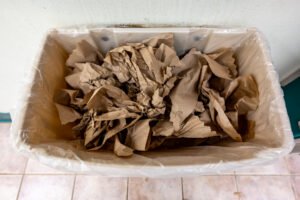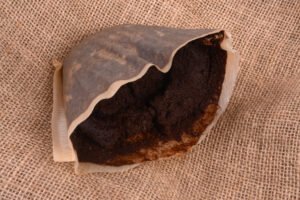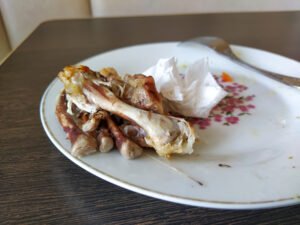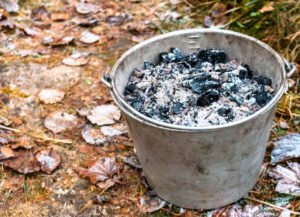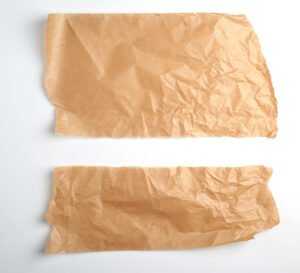Pumpkins are high in nutrients. They are not only used for delicious dishes but also for the Halloween festival. But are pumpkins useful in gardens? Well, because pumpkins are nutritious, they can be used as fertilizer. But can you compost pumpkins? If so, how?
Key Takeaways
- Pumpkins are compostable as they serve as an excellent source of green material and add Nitrogen and moisture to your compost.
- Trench composting, vermicomposting, Bokashi, and bin composting are four effective methods for pumpkins, which are explained below with steps.
- If you’re using Halloween lantern pumpkins, remove the candle wax and other non-degradable materials and chop them into fine pieces.
- When used as compost, pumpkins work as an effective soil amendment. It has several other benefits which you must know!
So, keep reading to learn everything about composting pumpkins, including tips, benefits, and other uses.
How to Compost Pumpkins
Pumpkins break down quickly, making them an ideal substitute for composting. Plus, they serve as a green material for composting, containing Nitrogen and 90% of water.
But as they are loaded with water, you need to add plenty of brown materials to your compost bins to prevent them from spoilage. But before adding the pumpkin to your compost pile, you must follow these two main steps.
- Clean your Pumpkin: Remove all the non-compostable decorations, wax, stickers, paint, etc., from your old pumpkin. Next, remove the seeds; while pumpkin seeds can break down, they might also germinate in the compost pile. So you must remove the seeds.
- Cut the Pumpkin into Pieces: It is crucial to cut the pumpkin into smaller pieces to escalate the decomposition. Smash the pumpkin with a hammer or cut it into pieces with a knife before composting it.
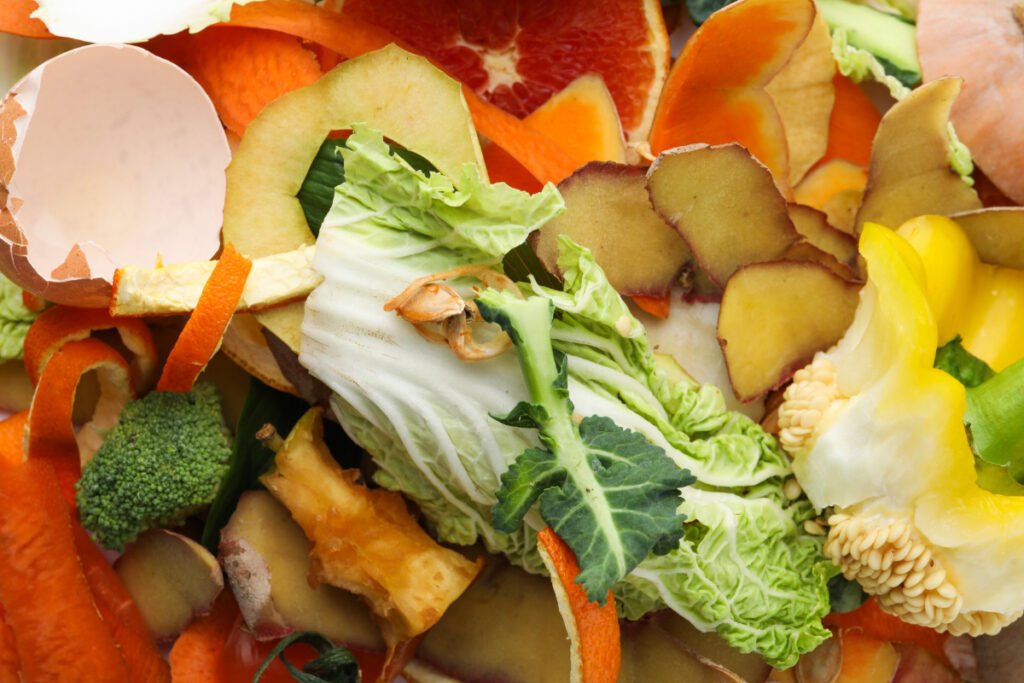
After you’ve completed these two critical steps, you can compost pumpkins using the following methods:
- Pit or Trench method
- Bokashi method
- Compost bin method
- Vermicomposting
1. Pit or Trench Method of Composting
It is the simplest and most efficient method to compost pumpkins. Here are the quick steps you need to follow to compost pumpkins through the pit or trench composting.
Step 1. Dig a Hole or Trench
Look out for a shady spot in your garden and dig out a pit (trench), ideally 1- 2 feet deep. Make sure to choose a place where the trench does not get disturbed while composting.
Step 2. Prepare the Bed with Browns and Greens
First, add a layer of dried leaves, wood chips, and other garden waste. Then, spread some oil over the brown materials and water them.
Add a layer of green materials, including smashed pumpkin, grass clippings, and food scraps like eggshells and peels, and cover them with a firm layer of soil up to 4-8 inches above the bed.
Step 3. Water the Trench
It is necessary to keep the soil moist, so water the trench. This will keep the healthy microbes active. If the pit becomes completely dry, the materials will not break down.
Once the compost is ready, you can directly grow your plants on the trench, and this serves as an organic fertilizer for your plants.
2. Composting via Worms or Vermicomposting
Like other gourds, pumpkin is popularly known as the favorite food of worms as it is sweet and contains plenty of water. But feed them to the limit, as overfeeding might kill your worms.

Follow these steps to compost the pumpkins effectively in a wormery:
Step 1. Set Up a Worm Bin
Buy a worm bin or choose an opaque container and place it in a low-light area of your home or garden. If you are using any container, make holes across it for aeration and drainage.
Step 2. Prepare the Bedding
Make the bedding by adding shredded paper or dried leaves and seal it with a layer of soil to provide grit to the worms. Water the bedding a little to keep it moist.
Step 3. Add Food Scraps
Mix the pumpkin pieces with some food scraps and add them to your worm bin. Leave it to decompose for two weeks.
Step 4. Add Worms
Add the composting worms to the wormery, and they will start moving towards the pumpkin pieces in no time. Cover the worm bin with gunny bags or shredded paper and water them lightly.
Step 5. Maintain Your Bin
Feed the frozen pumpkin pieces and other food waste whenever you see a food shortage in the bin. And keep an eye on the moisture levels and turn the worm bin occasionally for aeration.
It takes 2-6 months for the vermicompost to be ready. However, pumpkins will break down within a week, and you can collect the worm castings from the corner and add new materials to your wormery.
3. Compost Bin Method
Composting in a bin is a popular method and needs surveillance in decomposition. Here is the procedure for composting pumpkins through this method.
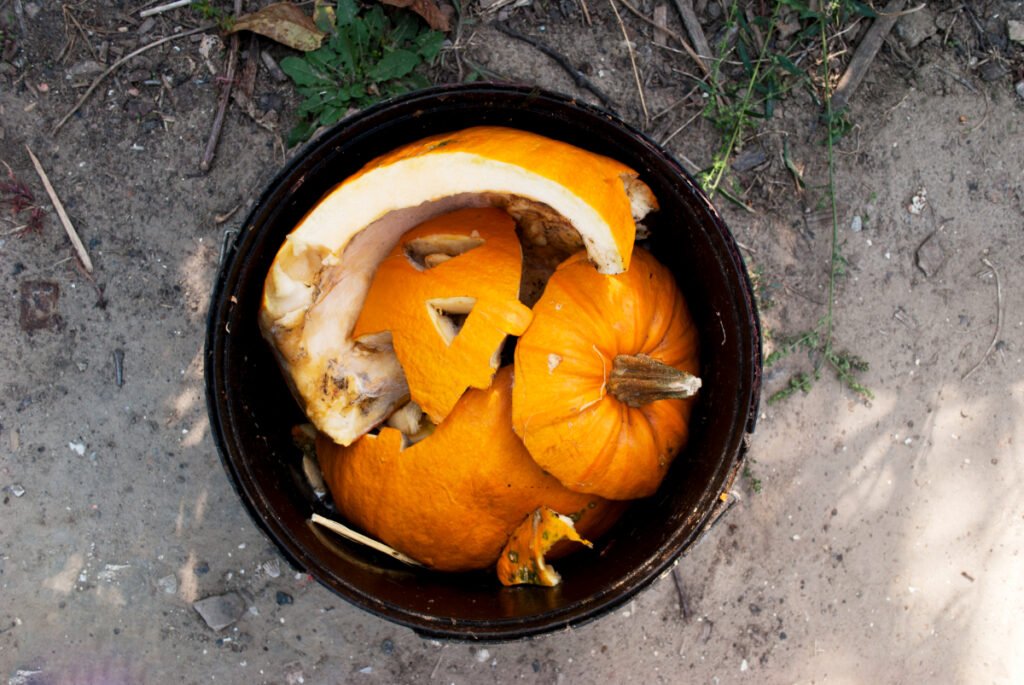
Step 1. Set Up Your Compost Bin
Place your compost bin in a shady corner of your garden and drill holes in the bottom of the bin for drainage.
Step 2. Add Composting Materials
Collect some brown materials like dried leaves, branches, shredded paper, and wood ash and layer them at the bottom of the bin.
Then, add pumpkin pieces mixed with other green materials like grass clippings, food scraps, and yard waste to the compost bin and water them.
Step 3. Repeat the Process
Fill the compost bin with brown and green materials alternately until you have added all the food waste to the pile. Then, cover the top layer with brown materials or soil and water it.
Step 4. Maintain the Compost Pile
Check for the moisture level in your compost bin and add the green or brown materials accordingly. Turn the pile once every 5-7 days to promote aeration.
Pumpkins will decompose within 5-10 days, and you can use compost to supplement the soil with nutrients.
4. Bokashi Composting for Pumpkins
Bokashi is an anaerobic method of composting that is more like fermentation. It is an easy and quick method suitable for city dwellers who wish to live a sustainable life.
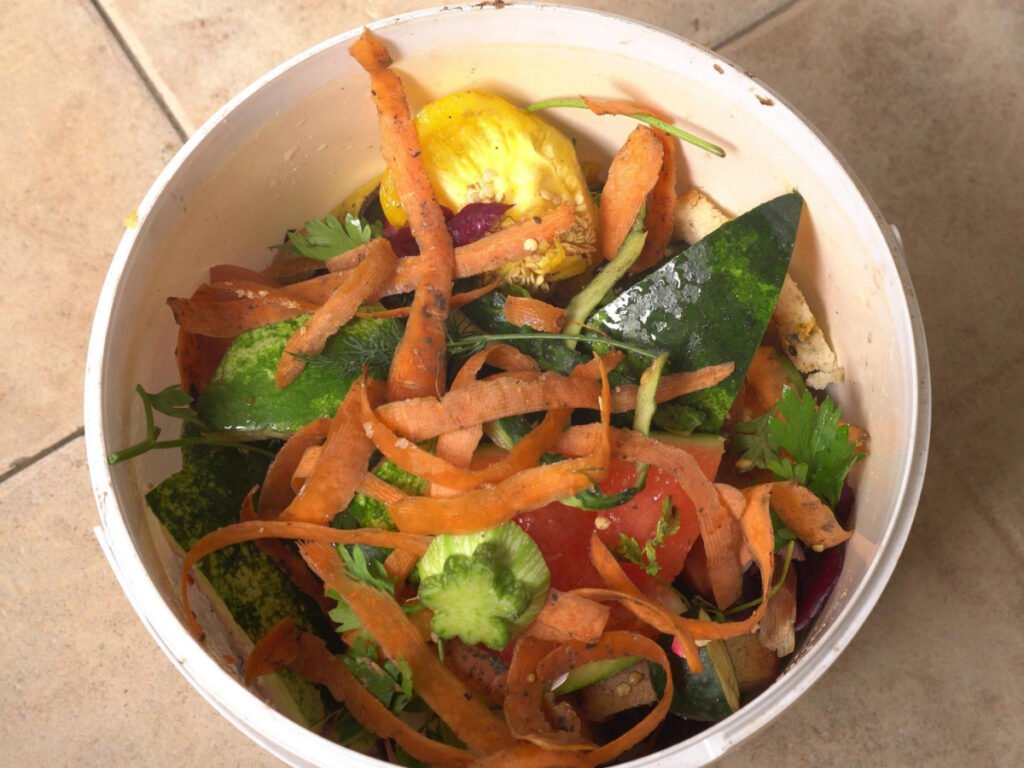
To get the best results from the bokashi composting, you need to follow a few systematic steps that are given below:
Step 1. Prepare a Bokashi Bin
Buy or make an airtight bokashi bucket and place it indoors or in a shady spot in your garden.
Step 2. Add Pumpkin Pieces
Fill your bucket with crushed pumpkin pieces. You can add other food scraps or yard waste to your bokashi bucket.
Step 3. Add Bokashi Bran
Add a firm layer of bokashi bran and press the materials firmly to release the air. Remember to use one tablespoon of bokashi bran for each cup of food waste.
Repeat the process until the bucket is filled and smoosh it down while adding the waste to the bucket. When done, spread some bran on the top. Then close the lid tightly and keep the bin undisturbed.
You can use a plate or a plastic cover to seal the bokashi bin.
Step 4. Drain the Liquid
The fermentation process releases excess liquid, called bokashi tea. Make sure to drain it every 2-3 days. This bokashi tea acts as an excellent liquid fertilizer that can be used for your houseplants by diluting it.
Step 5. Bury or Compost the Leftover Material
It takes about two weeks for the fermentation process to be completed. However, this method does not give a finished compost; you need to add the fermented waste to your compost bin or the idle soil.
Collect the pre-compost from the bokashi bucket and add it to your compost, as it is still acidic and might be harmful to your plants. You can also bury it in a fallow land in your garden.
Since the pre-compost is already fermented, the breakdown process is quick and takes up to 2 weeks to complete.
Why Should You Not Throw Away Pumpkins
According to data from EPA, more than 1 billion pounds of pumpkins get wasted and thrown into dump yards by the US residents every year, which contributes to 5.3 million tonnes of annual food waste in landfills.
This leads to the release of methane gas that produces vast amounts of carbon dioxide in the atmosphere and causes climate change. So it is high time to choose an alternative to reduce this wastage. Composting can be a solution to minimize the waste going to landfills.
Moreover, pumpkin provides rich nutrients to the compost; therefore, it’s best to compost them instead of throwing them away.
Benefits of Composting Pumpkins
Pumpkin is a versatile vegetable for many purposes in your kitchen and garden. If you are not convinced yet, look for the benefits it holds while they are composted.
- Pumpkins make an excellent source of green material as they are rich in nitrogen and contain 90% water.
- Pumpkin compost can enrich your soil with several beneficial nutrients like Vitamin A, Copper, Iron, Potassium, Magnesium, and Phosphorus.
- They are excellent soil amendments and serve as a natural fertilizer for your plants.
- Composting pumpkins helps you reduce huge amounts of food waste going to landfill.
- They are easy to compost and reduce the cost of purchasing synthetic fertilizers.
Additional Tips for Composting Pumpkins
Composting pumpkin is handy and easy, but when you do it correctly, it’s even more efficient and effective. Here are some interesting tips to consider while composting pumpkins.
- If you are using carved pumpkins from jack-o’lanterns, remove the candle wax, glitter, and decoration (if any).
- Avoid using painted pumpkins unless it is a water-based paint.
- Cut the pumpkins into small pieces or smash them before using them for composting.
- While making the compost from pumpkin, add more brown materials like paper, dried leaves, or other yard waste to balance the moisture levels.
- You can also add old pumpkins or rotten pumpkin pieces to your compost. But make sure to remove the seeds or crush them before composting.
- When using pumpkins in a worm bin, you can freeze the leftover pumpkin as the frozen pumpkin is soft and easy to digest by the worms.
Other Uses of Pumpkins In the Garden
In addition to composting, pumpkins can be used in a variety of other exciting ways in the garden. Let’s take a look at some of the applications.
1. Bury Them Directly in the Soil: Pumpkins can be buried directly in the soil. If you do not have a composting setup, dig a hole near your plants, add the unwanted pumpkins and cover the soil.
You can also grow your plants over the pumpkin patch. Pumpkins will decompose naturally and release nitrogen and nutrients into the soil, ultimately nourishing your plant.
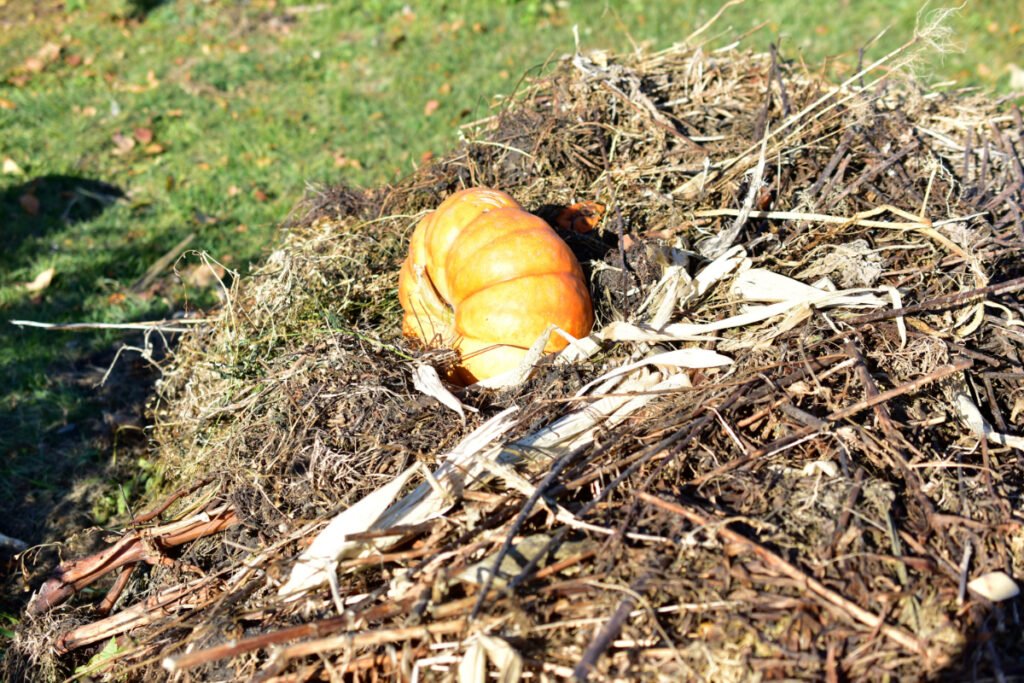
2. Use them as a Mulch: You can use leftover pumpkin as a mulch to suppress weeds and enrich your soil. However, cut them into smaller pieces and cover them with dried leaves or newspaper to keep the rodents away.
3. Make a Pumpkin Planter: Pumpkins serve as a good planter. To make the planter, cut the top portion of the pumpkin and scoop out the flesh and seeds. Now fill it with potting soil and place your seeds.
When your plant starts growing in the pumpkin planter, you can plant it directly in your garden along with the planter. The pumpkin will decompose eventually, adding more nutrients to the soil.
Are rotting pumpkins good for the soil?
Yes, rotting pumpkins are good for the soil as they are rich in nutrients and can be used as a natural fertilizer. When a pumpkin is rotten, it breaks down faster, turning into a rich soil amendment.
How long does it take to compost pumpkins?
A whole pumpkin takes up to 8 to 12 weeks to decompose. But when you use chopped pieces of pumpkin, they will break down within 5-10 days. The decomposition process, however, also depends on the moisture and temperature in your compost pile.
Which parts of the pumpkin are compostable?
All parts of the pumpkin, including the stem, skin, flesh, gut, and seeds, are compostable. Make sure to cut the pumpkin parts into pieces and remove the seeds or crush them before tossing them into the compost bin.
Can you compost pumpkin seeds?
Yes, you can compost pumpkin seeds, but there is a chance of germinating a pumpkin plant in your compost pile. To avoid this, boil the seeds and use the water along with the seeds in your compost pile. You might also consider crushing the seeds before adding them to your compost. This will add nutrients and eliminate the risk of sprouting in your bin.
How to identify if a pumpkin is ready to compost?
When the pumpkin changes its color and starts to become dark brown, it indicates that it is beginning to rot, and it is the right time to put it in the compost bin. Also, if the pumpkins are becoming soft and mushy, they can no longer be consumed and are ready to compost.
Which pumpkins do you need to keep away from composting?
The Halloween pumpkin that is used as a lantern and contains paint, glitter, or preserving sealant made of synthetic ingredients needs to be kept away from composting.
What should I do with the old pumpkin?
Old pumpkins have the potential to become a soil amendment, your favorite dish, or a snack for your favorite animal or wildlife.
Pumpkin is a nutrient-rich soil amendment that makes a great addition to your compost and garden. Besides, pumpkins are loved by wildlife. So, you feed the old, leftover pumpkin to small animals like squirrels. You can also participate in community fun activities like pumpkin smash.
Now, you have many reasons to avoid throwing pumpkins in the trash. So, make sure to compost some pumpkins this Halloween season. And if you want to learn about composting another common kitchen waste, Eggshells, we will walk you through it!
Happy Composting!


